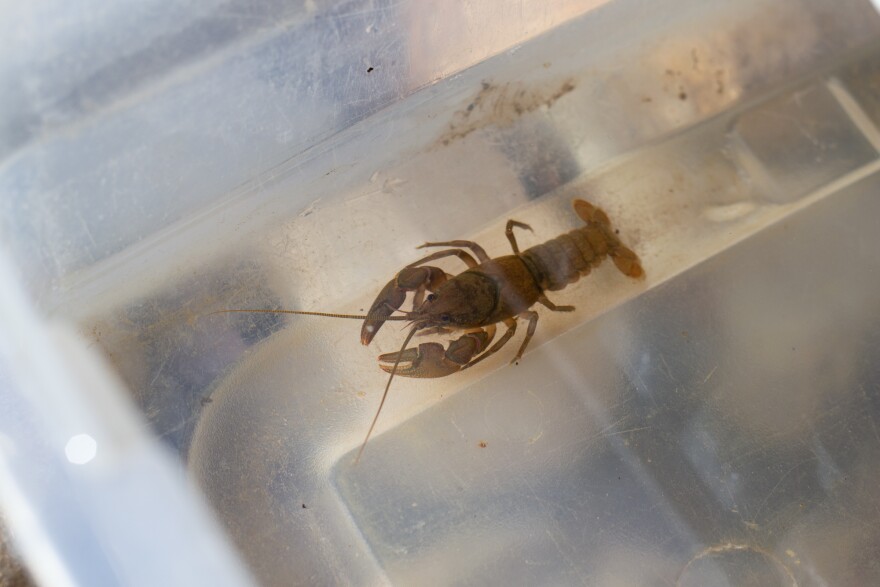WMRA | By Randi B. Hagi

Randi B. Hagi
Students from Highland County spent a recent school day at Elkhorn Lake learning about watershed health via canoe adventure. WMRA's Randi B. Hagi reports.
[kids splashing, laughing]
A lively class of sixth graders from Highland County got a hands-on lesson in water quality, ecosystem health, and canoe navigation in early November. A Chesapeake Bay Foundation field trip took them to Elkhorn Lake – a 54-acre reservoir in the mountains of western Augusta County. They started by learning the water's path to the sea with Brooke Newton, who manages the canoe program in this part of the state. She traced the flow of the lake into the North River to the South Fork and Shenandoah proper –
BROOKE NEWTON: And then the Potomac River, of course, flows into the –
STUDENTS: Chesapeake!
BROOKE: Yes! So we've got quite a few littler streams and creeks and rivers that make us connected.

Randi B. Hagi
They unloaded canoes under the tutelage of educator Shepherd Waldenberger –
SHEPHERD WALDENBERGER: Alright, ready? One, two, three! [lifting a boat off the trailer] Slide it straight off, alright, and gently roll it down.
… and got a lesson in paddling and steering.
WALDENBERGER: If I reach out behind me, drop it in, and push out, we're gonna make a nice turn to the right. If you need to do it more, you can do it more. If I want to turn the other way, I'll say, "switch!" Which means you guys switch to the other side for me, and I'll reach way out behind me [splash] and I'll push out, and we'll make a nice turn to the left.
STUDENTS IN UNISON: Oooo! Aahhh!
Newton told me that one of their main goals is to teach kids that what they do to the water in their own backyards has far-reaching impacts.
NEWTON: We run a lot of our canoe experiences on the western portions of the rivers of the South Fork of the Shenandoah and the upper reaches of the James River, so we just want to have people understand that even though maybe you haven't seen the Chesapeake Bay — maybe never, maybe only a few times – that we are still 100% connected, and everybody lives downriver from somewhere, so it's up to us to figure out what's happening up here with the water that we're sending out into our smaller tributaries and eventually out into the Chesapeake Bay.

Randi B. Hagi
After paddling out onto the lake, the kids raced to collect small sections of pool noodles attached to laminated cards, each printed with a different pollutant.
STUDENT: Cleaning products.
NEWTON: Cleaning products, excellent!
Newton explained how nutrient pollution, comprised of excess phosphates and nitrates from fertilizer, can fuel harmful algal blooms that deprive the water of oxygen and light.

Randi B. Hagi
Sixth grader Haven said the pollution game was her favorite part of the trip.
HAVEN: Probably trying to pick up the trash when we were canoeing. … I've learned how algae gets its nutrients and how fish filter out the oxygen.
Students rode three to a canoe, or two with an adult – the person in front was tasked with being the powerhouse paddler, the rear was the rudder, or captain, and –
HAVEN: Yeah, I'm the middle meatball!
Cory Conger and Felicity Zimmerman work for the restoration side of the foundation, inspecting riparian buffers and helping farmers implement regenerative practices. They joined the field trip and helped the kids paddle – or, took directions.
CORY CONGER: One of them has been in a kayak before and one of them has never paddled in a boat, and they are both listening to instructions and doing very well, so I'm pleased!
FELICITY ZIMMERMAN: The one said she had … canoed in Maine with her family and everything. … I'm the captain and I'm supposed to be telling them to switch, and all that, but they're really telling me to switch, and I love it!
After a lunch break on shore, the kids used various equipment to test the water on metrics like temperature, pH, and dissolved oxygen in parts per million.
WALDENBERGER: Alright, what's the top number? Does it have D.O. and then a number?
STUDENT: Eight-point-fifty-one.
WALDENBERGER: Whoa, that's really close to your hypothesis!

Randi B. Hagi
They gave the lake an "A" or "A-plus" in every subject except phosphates, which earned a "D." For the final activity, the students rolled up their jeans and waded into a feeder creek to catch critters in big, yellow nets.
[stream rushing over rocks]
CHORUS OF STUDENTS: Skeeeee! Oh, a crawdad! Where? Grab it! Grab it! Get 'im in here! Yeah! [applause, laughter] CRAWDAD!!
The crawdads were very popular – but it was the macroinvertebrates, such as insect larva and nymphs, that were most illuminating. Their presence indicates a healthy aquatic environment.

Randi B. Hagi
WALDENBERGER: Some of these smallest creatures can tell us the most about the health of the ecosystem!
P.E. and Health Teacher Cindy Wood said they've been taking field trips with the foundation for years. The most important lesson the kids learn?
CINDY WOOD: I think just realizing the pollution or what happens here ends up all the way down to the Chesapeake Bay, because we probably have kids here that've never been to the beach, so they probably don't realize, being this far away, the impact.
The Chesapeake Bay Foundation provides environmental education programming to more than 23,000 people each year. The application window for spring field trips for grades four and up is currently open through November 22nd. One-day programs cost $400 after subsidies from state and private funding, and teachers can apply for fee waivers.

Randi B. Hagi

